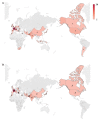Trends in the Epidemiology of Pneumocystis Pneumonia in Immunocompromised Patients without HIV Infection
- PMID: 37623583
- PMCID: PMC10455156
- DOI: 10.3390/jof9080812
Trends in the Epidemiology of Pneumocystis Pneumonia in Immunocompromised Patients without HIV Infection
Abstract
The increasing morbidity and mortality of life-threatening Pneumocystis pneumonia (PCP) in immunocompromised people poses a global concern, prompting the World Health Organization to list it as one of the 19 priority invasive fungal diseases, calling for increased research and public health action. In response to this initiative, we provide this review on the epidemiology of PCP in non-HIV patients with various immunodeficient conditions, including the use of immunosuppressive agents, cancer therapies, solid organ and stem cell transplantation, autoimmune and inflammatory diseases, inherited or primary immunodeficiencies, and COVID-19. Special attention is given to the molecular epidemiology of PCP outbreaks in solid organ transplant recipients; the risk of PCP associated with the increasing use of immunodepleting monoclonal antibodies and a wide range of genetic defects causing primary immunodeficiency; the trend of concurrent infection of PCP in COVID-19; the prevalence of colonization; and the rising evidence supporting de novo infection rather than reactivation of latent infection in the pathogenesis of PCP. Additionally, we provide a concise discussion of the varying effects of different immunodeficient conditions on distinct components of the immune system. The objective of this review is to increase awareness and knowledge of PCP in non-HIV patients, thereby improving the early identification and treatment of patients susceptible to PCP.
Keywords: Pneumocystis; epidemiology; immunocompromised; immunodepleting monoclonal antibodies; non-HIV/AIDS; organ transplantation; primary immunodeficiency.
Conflict of interest statement
The authors have no conflict of interest in this study.
Figures




Similar articles
-
Semiquantitative Real-Time PCR to Distinguish Pneumocystis Pneumonia from Colonization in a Heterogeneous Population of HIV-Negative Immunocompromised Patients.Microbiol Spectr. 2021 Sep 3;9(1):e0002621. doi: 10.1128/Spectrum.00026-21. Epub 2021 Aug 4. Microbiol Spectr. 2021. PMID: 34346746 Free PMC article.
-
A therapeutic vaccine strategy to prevent Pneumocystis pneumonia in an immunocompromised host in a non-human primate model of HIV and Pneumocystis co-infection.Front Immunol. 2022 Dec 6;13:1036658. doi: 10.3389/fimmu.2022.1036658. eCollection 2022. Front Immunol. 2022. PMID: 36561749 Free PMC article.
-
Successful management of concurrent COVID-19 and Pneumocystis Jirovecii Pneumonia in kidney transplant recipients: a case series.BMC Pulm Med. 2023 Nov 21;23(1):458. doi: 10.1186/s12890-023-02764-2. BMC Pulm Med. 2023. PMID: 37990199 Free PMC article.
-
Pneumocystis Pneumonia in Solid-Organ Transplant Recipients.J Fungi (Basel). 2015 Sep 28;1(3):293-331. doi: 10.3390/jof1030293. J Fungi (Basel). 2015. PMID: 29376913 Free PMC article. Review.
-
Exploring the Differences in Pneumocystis Pneumonia Infection Between HIV and Non-HIV Patients.Cureus. 2022 Aug 6;14(8):e27727. doi: 10.7759/cureus.27727. eCollection 2022 Aug. Cureus. 2022. PMID: 36106266 Free PMC article. Review.
Cited by
-
Evaluation of the JF5-based Aspergillus galactomannoprotein lateral flow device for diagnosing invasive aspergillosis in cancer patients.Eur J Clin Microbiol Infect Dis. 2024 Jun;43(6):1221-1229. doi: 10.1007/s10096-024-04830-x. Epub 2024 Apr 16. Eur J Clin Microbiol Infect Dis. 2024. PMID: 38625450
-
Risk factors and multi-pathogen infections in kidney transplant recipients with omicron variant pneumonia: a retrospective analysis.BMC Infect Dis. 2024 Jun 4;24(1):559. doi: 10.1186/s12879-024-09444-4. BMC Infect Dis. 2024. PMID: 38834974 Free PMC article.
-
Evolving spectrum of Pneumocystis host specificity, genetic diversity, and evolution.FEMS Microbiol Rev. 2025 Jan 14;49:fuaf006. doi: 10.1093/femsre/fuaf006. FEMS Microbiol Rev. 2025. PMID: 39971735 Free PMC article. Review.
-
Clinical course and prognostic factors of Pneumocystis pneumonia with respiratory failure in non-HIV patients.Front Cell Infect Microbiol. 2024 Jul 10;14:1380494. doi: 10.3389/fcimb.2024.1380494. eCollection 2024. Front Cell Infect Microbiol. 2024. PMID: 39055982 Free PMC article.
-
Retracing the evolution of Pneumocystis species, with a focus on the human pathogen Pneumocystis jirovecii.Microbiol Mol Biol Rev. 2024 Jun 27;88(2):e0020222. doi: 10.1128/mmbr.00202-22. Epub 2024 Apr 8. Microbiol Mol Biol Rev. 2024. PMID: 38587383 Free PMC article. Review.
References
-
- Gajdusek D.C. Pneumocystis carinii as the cause of human disease: Historical perspective and magnitude of the problem: Introductory remarks. Natl. Cancer Inst. Monogr. 1976;43:1–11. - PubMed
-
- Sepkowitz K.A. Pneumocystis carinii pneumonia among patients with neoplastic disease. Semin. Respir. Infect. 1992;7:114–121. - PubMed
Publication types
Grants and funding
- 32200168/National Natural Science Foundation of China
- 20210302124039/the Basic Research Projects of Natural Sciences in Shanxi Province
- 2020-PT320-005/Central Public-interest Scientific Institution Basal Research Fund
- n/a/federal funds from the Intramural Research Program of the United States National Institutes of Health Clinical Center
LinkOut - more resources
Full Text Sources

